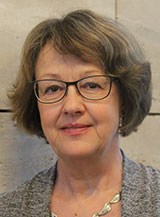Communicating with Aphasia Patients
Lise Randrup Jensen has, after several years as a practicing speech-language therapist, devoted herself to research and development, with an emphasis on applying knowledge from research in practice, e.g. in hospitals. The focal point of her work is patients who experience aphasia, i.e. decreased linguistic ability, following a stroke.

Lise Randrup Jensen
Aphasia has obvious human consequences, as it severely impairs patients’ ability to communicate with their families and with health professionals, e.g. about their condition and treatment. From a medical perspective, communication problems between aphasia patients and health professionals can be a source of misdiagnosis, lead to inappropriate forms of treatment, and reduce the effect of the subsequent rehabilitation programme. Aphasia also presents challenges to hospitals with regard to meeting the accreditation requirements of the Danish Quality Model (DDKM, see www.ikas.dk/IKAS/English.aspx), i.e. keeping every patient informed of the reason for admission and about his or her treatment plan.
Case description
The project is based in Glostrup Hospital’s Department of Neurology. The overall objective is to ensure that patients with aphasia may be informed about and engaged in their own treatment. In many cases, the patient with severe aphasia is excluded from the flow of examination results and treatment plans in spite of preserved intellectual competence. The project makes use of the Canadian method Supported Conversation with Adults with Aphasia (SCA), the aim of which is to enhance health professionals’ communication with aphasic patients. Lise Randrup Jensen and Annelise Løvholt, speech-language therapist at Glostrup Hospital, train health professionals in improving dialogue with patients and measure the subsequent results.
The SCA method is based on two main principles:
- The acknowledging principle means that the staffs explicitly recognise that the patient’s problem is limited to the use of speech, i.e. the patient is a competent person, whose knowledge is intact, but who cannot express it.
- The visualizing principle consists of techniques for communicating with patients and ensuring that they can understand and make themselves understood. For example, the question “How are you feeling?” may be accompanied by the presentation of a visual scale on where the patient can mark his response.
The method also includes the use of pictures and drawings, yes/no questions and keywords to improve communication with patients who have lost the ability to speak. To be successfully deployed, the techniques must be used systematically and consistently, in a manner that takes into account the knowledge, work routines and attitudes of the method’s users, i.e. the hospital staff.
Impact
The project has resulted in a set of guidelines, a number of specific tools and a workshop programme for health professionals. In a pilot project, the researchers trained eight employees from four of Glostrup Hospital’s wards as super users of SCA. Through four steps - involving meetings, workshops, role play, video and subsequent evaluation - the pilot project resulted in 80 hospital employees being able to use the SCA techniques in their everyday work. The training continues at Glostrup Hospital. A total of 280 employees are now able to use SCA in practice. Aarhus University Hospital and Svendborg Hospital are now also introducing the method, which is not only a useful tool for healthcare workers, but also demonstrates to relatives how communication with aphasia patients is possible.
Further info
L. R. Jensen et al.: Implementation of supported conversation for communication between nursing staff and in-hospital patients with Aphasia. Aphasiology, September 2014
Contact
Lise Randrup Jensen
Associate Professor, PhD, Department of Nordic Studies and Linguistics
E-mail: randrup@hum.ku.dk
Tel. +45 35 32 86 70
